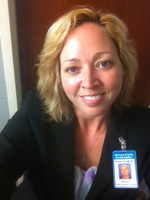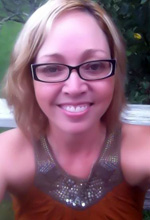The International Reading Association (IRA) enjoys hearing stories from members working in the field of literacy. The popular Member of the Month series just moved from the Engage/Teacher to Teacher blog to its new home on Reading Today Online. We hope you enjoy these monthly features that profile IRA members from a variety of backgrounds, disciplines, and locations. Without further ado, let us introduce Bobbi Faulkner from North Carolina.
 Barbara (Bobbi) Faulkner is currently pursuing a doctorate in Educational Leadership at Appalachian State University. She has worked for several years as a high school hybrid—teaching English/Reading/and ESL classes in a sheltered format. In her current role, she is a mentor working with beginning high school teachers in a variety of disciplines.
Barbara (Bobbi) Faulkner is currently pursuing a doctorate in Educational Leadership at Appalachian State University. She has worked for several years as a high school hybrid—teaching English/Reading/and ESL classes in a sheltered format. In her current role, she is a mentor working with beginning high school teachers in a variety of disciplines.
When did you decide you wanted to be a teacher? How did your career progress to working with English as a second language students/English language learners (ESL/ELL) and mentoring?
I did the typical playing-school-with-stuffed-animals thing as a kid. I also taught school to my younger and older cousins in the summer using the Summer Bridge books. I liked getting to explain things to them and to see the way their faces changed when they began to understand. Admittedly, at that age, a small part of me delighted in being bossy. Since those childhood days, my desire to teach was solidified in high school when my English teacher, Dr. Melissa Eggers, took me under her wing, mentored me, and helped me to get scholarships, one of which was the North Carolina Teaching Fellows Scholarship. She inspired me to want to teach not only English, but also to teach and care for students, to want to reach out to those in need—academically, financially, socially, or otherwise.
I got involved with English Language Learners when I student taught in Guadalajara, Mexico. Although my certification is high school English, I taught fourth grade to students of a variety of nationalities, students who spoke a variety of first languages. These students were very fluent in English, which impressed me greatly. They struggled with the cultural differences encountered in texts. For example, I remember being surprised when we read a story about winter and snow and I had to explain what that was like because they have two seasons—rainy and dry—and having to explain what a dime is.
My first teaching job after I graduated was working part-time in an elementary school ESL program in Boone, North Carolina. With this population, I discovered the differences between affluent students in Mexico refining their usage of a second or third language and the immigrants in the United States who typically faced financial difficulties as well as the struggles each wave of immigrants to the US have encountered. My students in Boone were at varying levels of proficiency—some were just beginning to learn the alphabet while others were struggling with reading comprehension.
Because this position was part time, it would not fulfill the requirements of my Teaching Fellows. Therefore, I took a position teaching high school English, and it was here, after completing my National Boards, that I realized that even for students whose first language is English, reading and reading comprehension can be a struggle. Prior to the National Board process, I had assumed that high school students knew how to read and understand a text and that they were just lazy when they couldn't get it. I saw just how little I knew about the process of reading or teaching it, and I went back to school at Appalachian University for a Masters in reading.
I held several teaching positions after that—I was an ESL teacher twice and a hybrid reading/English/ELL teacher three times. After those experiences, I felt well-equipped to help teachers in other disciplines, especially those just starting out. As an ESL teacher, I often co-taught, and that experience, combined with getting my EdS in adult education and beginning my doctorate in Educational Leadership led me to want to affect education in a broader way. Mentoring allows me to have this reach beyond one classroom. I liken my role to that of a bee—I take pollen (other teachers’ knowledge and craft, and spread it to as many flowers as I can (my beginning teachers).
In your current role as a mentor working with beginning high school teachers in a variety of disciplines, do you find that new teachers are surprised by any aspects of working in a school?
For all of my beginning teachers, their biggest surprise is a mismatch between their expectations and reality. They expect to be able to come in and teach the lessons they have labored over to a rapt audience, to students who are motivated and engaged. Often, however, they are confronted with apathy and/or more overt disciplinary issues that they feel ill-prepared for by college and student teaching. Classroom management is even more of a struggle for my lateral entry teachers. Both lateral and regularly certified beginning teachers tend to want to preserve their positive relationships with students and feel that disciplining them is contrary to that goal. By the time they realize that students are taking advantage of their tenderheartedness, they feel that it is too late to start anew and become more stern.

What’s the best advice you could offer someone new to the profession?
Read Harry Wong’s The First Days of School. Classroom management is exactly that—managing student behavior. Before you step foot in your classroom, have a plan for everything. Decide what your procedure will be for handling late work, allowing students to use the rest room, turning work in, handing papers back out, working in groups, and so forth. Be precise about your expectations and rehearse these procedures with your students, frequently. Structure is a key to preventing misbehavior. Have a routine for starting class and ending class. Arrange your room in a way that students know where to look to see what they are doing for the day, to see what their homework is, and to see important upcoming dates. Finally, engaging lessons are the biggest key to avoiding bad behavior.
You have a lot of experience with ELL students. How is teaching them the same and how is it different than teaching native English speakers?
Whew. You like asking the easy questions. Seriously, I suppose the biggest difference depends on the proficiency level of the student. When I teach a high school class of ESL students who are new to the country, our focus is on basic vocabulary and even phonics, on learning the building blocks of the language and how to put those together to produce speech and writing, on how to extract meaning from listening and reading, and on moving beyond having to translate. Learning to read and write in a second language is complicated further for some students who have weak literacy skills in their first language or who never learned to read or write in that language. Students who are of medium proficiency tend to have good social language, which can often lead a teacher to wonder why they struggle academically. These students are working on gaining a knowledge of academic vocabulary and can be easily confused by material that is presented in one way and then paraphrased differently, for instance. My most proficient ESL students are mostly indistinguishable from non-ESL students, and they differ from those that have exited the program in that they perhaps lack the most technical vocabulary or the ability to write essays with complex structures and elaborate examples. For all ESL students, they have positive and negative transfer between their L1 (first language) and L2 (English) that I must be aware of and use to help them navigate pitfalls of misconceptions and to make a bridge between what they already know about language and its domains of listening, speaking, reading, and writing.
Teaching ESL students is the same as teaching any other student in the sense that they need to be engaged and motivated. All students learn best when they are interested in the material, and I have found that the best way to interest them is to give them choice. I find out what their hobbies, likes, and dislikes are and use those as much as possible in my teaching. As far as teaching English Language Arts, both groups of students learn best when the SIOP model is followed, when I have thoughtfully prepared a lesson, activated and built background knowledge, provided students with comprehensible input (for example, text at their instructional reading level), used strategies to help them derive meaning from a text, allowed them to collaborate with one another, given them a chance to practice and apply what they have learned, delivered the lesson in a way that is dynamic, and then reviewed the material and assessed both formatively and summatively.
You are interested in researching adolescent literacy. What attracts you to this age group?
High school teachers assume that their students come to them knowing how to read. While they may be able to read, an astonishing number of them are at least two grade levels behind, which makes learning difficult in all subjects. Reading and writing are both integral skills necessary to being prepared for life in the 21st century, in our knowledge driven world. However, this age group has often been neglected by the research community. Also, I feel that they have been given up on by this point, and if they are struggling readers, they have often given up on themselves and schooling. I feel that even if they can only gain two years in terms of reading proficiency and they entered high school reading at a third grade level, they can leave functionally literate. Literacy to me is a civil rights issue, and I want to see more done to help our struggling readers.
As a literacy educator, how do you motivate kids to want to read?
I discovered the term “aliterate” several years ago when I was preparing a workshop about how to motivate students to read. Many of our students these days say they do not enjoy reading, so it is not just our struggling readers who need to be motivated. I engage them by providing them with choice. I have a well-stocked classroom library of over 1,500 titles that range from a kindergarten reading level up to college on topics from Tupac to deer hunting, including the Twilight books alongside Sharon Draper’s wonderful books. I use reader response, challenging students to connect the texts to their lives. We have lively discussions. We read and we create. I am constantly looking for ways to make the reading relevant to them. I show them that reading is fun. Reader’s theater is a favorite activity. They enjoy the freedom of SSR and like making book trailers to advertise the books they have read. I think outside of the box and lure them to books and other types of text by ANY MEANS NECESSARY!
What made you decide to pursue your doctorate in Educational Leadership at Appalachian State University?
The more I worked with struggling readers, the more I became aware of how little we know about how to help struggling adolescent readers. Appalachian has a super-star cast of reading experts, such as Dr. Darrell Morris, Dr. Gary Moorman, Dr. Tom Gill, Dr. Bob Schlagel, Dr. Beth Frye, and Dr. Carla Meyer. I learned so much from the master’s program at Appalachian and knew that I wanted to continue my studies with this group.
Which professional development books have you found influential in your education?
Wong’s First Days of School, Mike Rose’s Lives on the Boundary, Atwell’s In the Middle, Tom Romano’s Blending Genre, Altering Style, Jim Burke’s Reading Reminders and Writing Reminders, Making Content Comprehensible for Secondary English Learners, the Words Their Way series, The Book Whisperer, Thinking Out Loud on Paper: The Student Day Book as a Tool for Fostering Learning, Hip Hop Poetry and the Classics, Backwards Planning: Building Enduring Understanding Through Instructional Design, Bringing Words to Life: Robust Vocabulary Instruction, To Be a Boy, to Be a Reader, Adolescent Literacy: Turning Promise into Practice, Readicide: How Schools are Killing Reading and What You Can Do About It, The Howard Street Tutoring Manual, Diagnosis and Correction of Reading Problems, and The Courage to Teach to name a few.
 What do you like to do when you’re not wearing your educator hat?
What do you like to do when you’re not wearing your educator hat?
Read. Write poetry. Play with my two children, Nadia and Gavin, 7 and 9 respectively. Sleep. Paint. Make jewelry. Make paper. I’m crafty and I have lots of energy, so I have a hard time with down time, probably because I haven’t had much of it since I have been on this educational journey. Playing in the mud and in the sun is a favorite. Doing the unexpected. I love to hike and swim and hula hoop and laugh.
What do you consider to be your proudest career moment?
Hmmmm. Probably receiving the Character Educator of the Year Award from the Kenan Institute. But presenting at CRLA’s national conference last year with Dr. Ari is a close second.
English Learners Resources from the International Reading Association Annual Convention
The New Engage Blog on Reading Today Online